You will be collected from your accommodation or the airport by 7:00 am and transferred for a short pre-departure meeting.
Heading north from Windhoek, you'll stop briefly at the small town of Otjiwarongo to gather supplies before continuing to Etosha. You'll enjoy a light lunch pack whilst “on the move”. You'll enter Etosha National Park and a game drive on your way to your overnight accommodation at Halali Camp.
The ‘game show’ in Etosha doesn’t stop when the sun goes down. All the Etosha camps have floodlit waterholes for extra wildlife-viewing opportunities.
Driving time: 4-5 hours
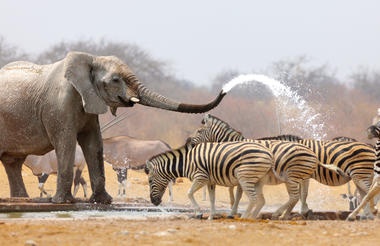
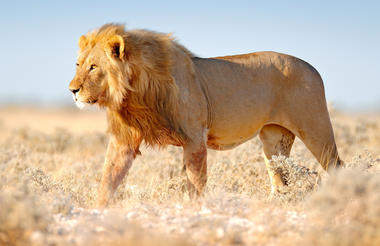
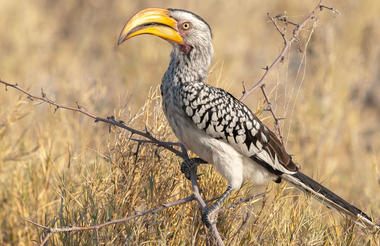
Afternoon game drive
You will have the whole day to explore Etosha and we want to make the most of it. The park gates open at sunrise and we aim to be on your way just as the sun breaches the horizon. Early morning is usually a productive time for wildlife viewing and first thing in the morning is a good time to catch big cats returning from the hunt.
You'll return to Halali for breakfast and to load your vehicle before heading out into the park once again in search of big animals. Etosha is a desert landscape and water is the most scarce natural resource. There are however numerous waterholes here, both natural and man-made, and your game-driving technique is to take in as many as possible. Here we hope that the game will come to you as the thirsty animals attend for a much-needed drink.
On your way today, you will stop to have a closer look at the Etosha Pan. You'll exit Etosha close to sunset and it is just a short drive to your accommodation.

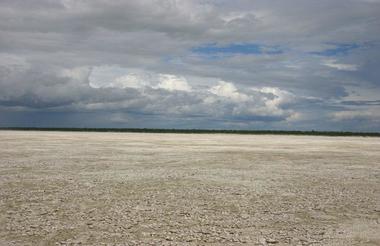

After breakfast, we aim to be on the road by 7:30 today. You'll head for the Skeleton Coast via the scenic route. South on the main road, passing the town of Outjo, then onward towards the west and picking up the gravel road as you travel through Damaraland. You'll also have a chance to meet some of the locals where we can find informal shops selling locally made souvenirs.
You'll continue your journey west and soon arrive at the coast and the chilly Atlantic Ocean. The whole coastline of Namibia is known as the Skeleton Coast. It is easy to see why this barren seaboard is so named with its forbidding mountains and barren beaches. Heading south on the coast road your next stop is a more recent shipwreck. You'll complete the final leg of your journey into Swakopmund. You'll check into your accommodation. Swakopmund boasts some truly excellent restaurants and your guide will be able to help you with recommendations and bookings.
Driving time: 5-6 hours
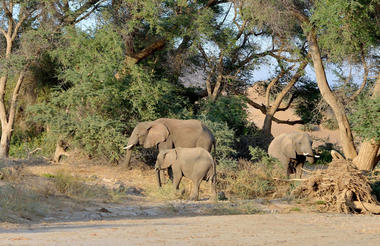
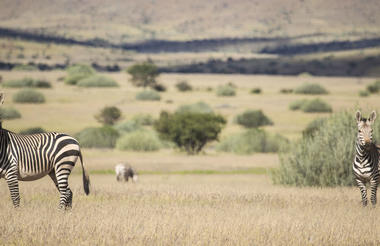
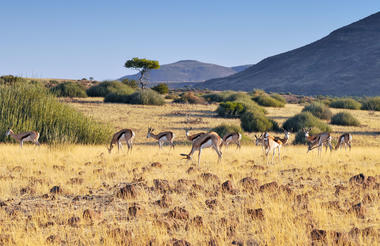
Making the most of your time at the coast, you'll leave Swakopmund at 11:30 am, giving you plenty of time to wander around town. Alternatively, there are optional activities available this morning. You'll head east into the desert. You'll cross the Namib gravel plains.
Then, you'll have two mountain passes to traverse this afternoon. You'll climb up from the banks of the river and over the pass, traveling through the mountain peaks and on to the second, smaller canyon of the Gaub River, a tributary of the Kuiseb. You'll emerge from the mountains onto a flat road and almost immediately cross the Tropic of Capricorn at 23.5 degrees. There is a signpost at this auspicious spot and stop for photos.
For today, your destination is the gateway to the dunes and Sossusvlei at Sesriem. You'll make your campsite under a huge, ancient camelthorn tree from where you can, in anticipation of your day tomorrow, glimpse the towering red dunes of the world’s oldest desert.
Driving time: 5 hours


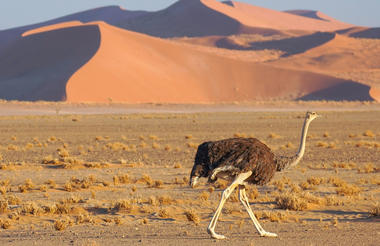
Morning
Swakopmund Adventure Activity
Sunrise in the dunes is the name of the game and that means a pre-dawn start. Your first stop will be at Dune 45, so named because it is 45 km from Sesriem. The best time to photograph the dunes is around sunrise and sunset. There is a 4x4 shuttle service that will transport you through the sandy terrain of the riverbed. You'll have time to explore the area on foot and to climb one of the highest dunes in the world, some towering 300 m above you, the views are breathtaking and justly famous.
You'll drive back to Sesriem for lunch and perhaps a dip in the swimming pool. In the afternoon, you'll take a short excursion to see the Sesriem Canyon. In the late afternoon, there is one further option with which to close our time in the world’s oldest desert. A short drive will take you to Elim Dune, for the best golden light before sunset. From here, if you would like to, it is a relatively short walk back, through the desert, to our camp.
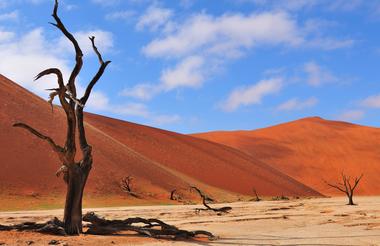
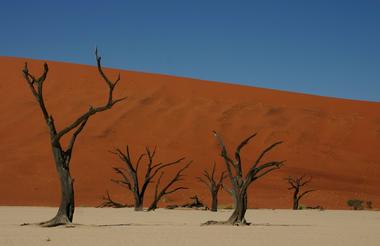
You'll have a scenic drive through the ever-changing desert, mountains, and open grassland. You'll continue your long drive south and your destination is Aus, located in the Aus Mountains above the plains of the Namib Desert. Aus was formally the site of a prisoner-of-war camp set up by the South African army to house German prisoners during the Second World War.
Your actual destination today is Klein Aus Vista located just outside Aus and just inside the private Gondwana Sperrgebiet Rand Park. We aim to arrive in the early afternoon and set up camp, giving you time to stretch your legs on the unguided hiking trails on the property. The landscape is wide open vistas and we are hoping for a spectacular sunset.
Driving time: 5 hours



Afternoon
You'll start early and travel through grasslands and wide open desert scenery on your drive toward the ocean. Desert-adapted horses run wild in this area and you need to keep a good look out for them. We are en route to the ghost town of Kolmanskop. You'll stop at Kolmanskop for a guided tour and the opportunity to photograph this unique and interesting site. On departure, you'll quickly cover the last few kilometers to Luderitz itself, well known for its unique and colorful colonial-style buildings.
You'll drive out onto the Luderitz peninsula and enjoy the scenery on the way to the historical monument at Diaz Point. As at Cape Cross, the first sign of European interest in this land was from the Portuguese, and in this case, it was the navigator Bartolomeu Diaz who landed here in 1487. You'll head back to your accommodation at Klein Aus Vista, taking a second opportunity to see the desert horses and arriving in time for a sundowner.
Driving time: 3 hours return
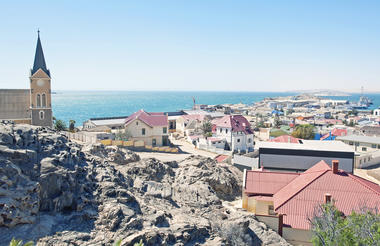
A long drive today but you'll take advantage of the tar road for the first part of the morning. You'll head east but soon turn south again to complete your traverse of Namibia’s southern region. Your first main stop this morning will be the incredible Fish River Canyon located in the /Ai-/Ais Richtersveldt Transfrontier National Park. You'll enter the park at the Hobas gate and from there, it is only a short drive to the main lookout point over the Fish River Canyon.
It is hard to leave such an impressive sight but you'll journey onwards, turning your heads once again to the north as the canyon marks the end of the southern leg of your trip. You'll be en route to Keetmanshoop, the main commercial and political center of Namibia’s south. A short stop here and then on to your overnight camp at the Quiver Tree Forrest. This is the last night of your safari and time to reflect on your amazing adventure as you sit around the campfire one last time.
Driving time: 6 hours



Today you will head back to Windhoek. Namibia is so rich in interesting things that it is impossible to drive for any great distance without passing places of interest and there are several worth mentioning along the way today. Still heading ever north your journey today takes you through the small centers of Mariental and Rehoboth. You will stop along the road today for a light lunch. We aim to be back in Windhoek in the late afternoon. You will be dropped off at your accommodation within the Windhoek City limits or the airport.
Driving time: ~5 hours
We recommend that departure flights are not scheduled for today.





